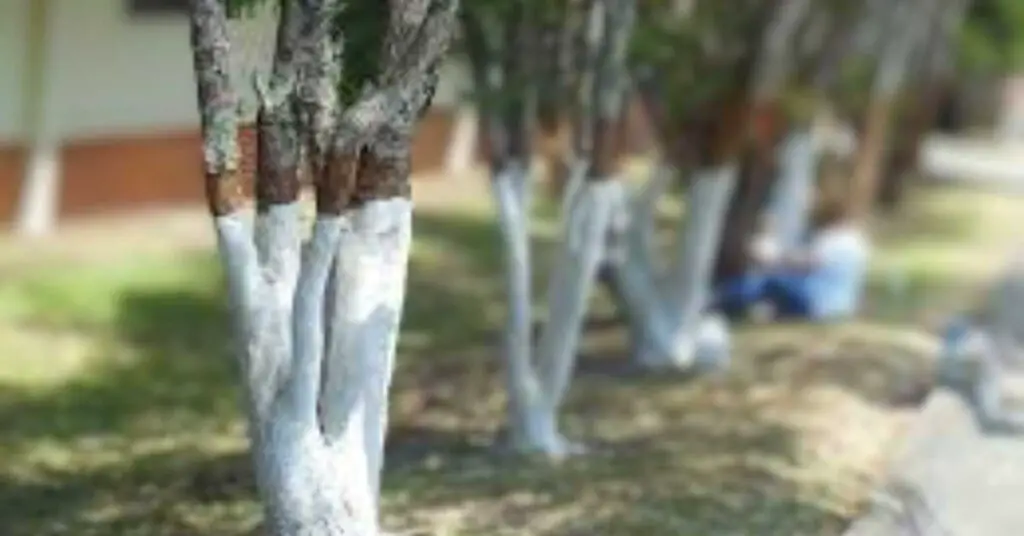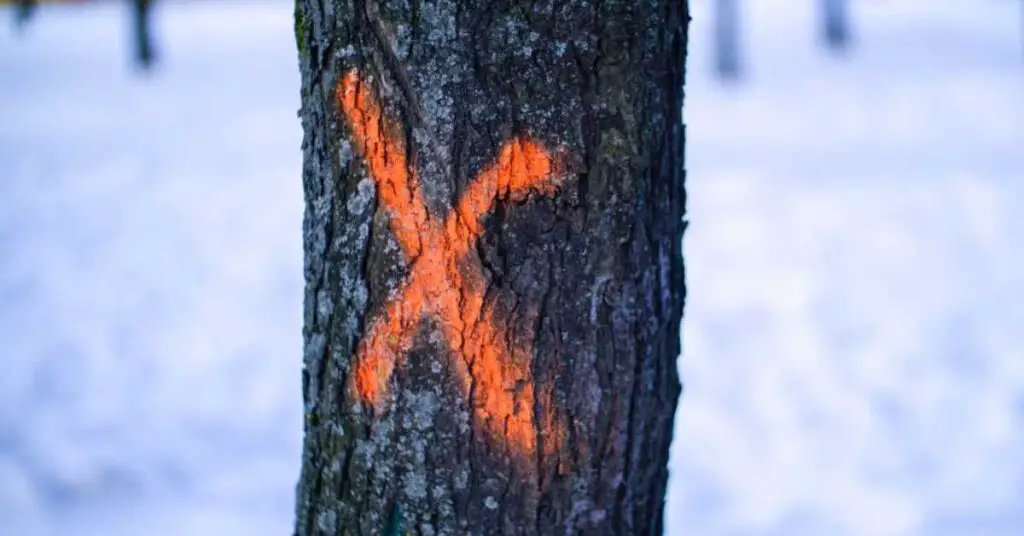Will spray paint kill a tree? Spray paint has the potential to harm trees, but it may not necessarily kill them outright. The extent of damage depends on factors such as the type of paint, the amount applied, and the tree species. While small amounts might not cause significant harm, repeated or large-scale exposure can lead to stunted growth, chronic stress, and, in extreme cases, death. To protect trees, opt for eco-friendly alternatives instead of using spray paint.
Hey there, fellow tree lovers! Have you ever wondered what happens when someone spray paints a tree? Or maybe you’ve seen a painted tree and thought, “Is that bad for the tree?” Well, you’re not alone!
In this blog post, we’ll dive into the world of spray paint and trees, exploring its potential impact on our leafy friends. So let’s get started, shall we?
Is Spray Painting Trees Common and Why Do People Do It?
Spray-painting trees is not an uncommon sight, especially in urban areas. It isn’t weird to see trees with painted trunks in community areas or in people’s yards as you drive down the street. People spray-paint trees for many different reasons.
People will spray paint trees to decorate their yards, mark trails, and mark trees that they want removed from their property. In addition to this, people will also spray paint trees to prevent pest damage and to help a tree heal after a limb was cut.
However, the question remains: is it harmful to the trees?

Does Spray Painting a Tree Hurt the Tree or the Environment?
Before we go any further, it’s essential to understand why knowing the effects of spray paint on trees is important. Trees are vital for our environment, providing oxygen, reducing air pollution, and offering habitat to countless species. If spray paint negatively impacts their health, we need to be aware and look for alternatives to protect these precious living beings.
Will Spray Paint Kill Tree Stumps?
Effect of spray paint on tree stumps
If you’re trying to get rid of a pesky tree stump, you might be tempted to reach for a can of spray paint. But will it actually kill the stump? In most cases, spray paint won’t have much of an effect on tree stumps. It may hinder the stump’s ability to sprout new growth, but it’s unlikely to kill it outright.
Alternative methods for removing tree stumps
Instead of spray paint, consider these more effective alternatives for removing tree stumps:
- Manual removal
- Grinding
- Chemical stump removal
- Rotting the stump with natural methods
| Method | Pros | Cons |
|---|---|---|
| Manual removal | Environmentally friendly, immediate results | Labor-intensive, may not work on large stumps |
| Grinding | Quick, effective | Noisy, expensive to rent equipment |
| Chemical stump removal | Effective, minimal labor | Toxic chemicals, slow process |
| Rotting with natural methods | Environmentally friendly, inexpensive | Time-consuming, may attract pests |
Is Spray Paint Bad for Trees?
The toxicity of spray paint
Spray paint contains various chemicals, including solvents, pigments, and propellants. Some of these chemicals can be toxic to trees, especially if they’re applied in large quantities or directly to the tree’s bark. While a small amount of spray paint might not cause significant harm, repeated exposure or large-scale application can have detrimental effects on a tree’s health.
Short-term and long-term effects on tree health
In the short term, spray paint can cause:
- Discoloration of leaves
- Reduced photosynthesis
- Damage to bark
Long-term effects may include:
- Chronic stress
- Stunted growth
- Increased vulnerability to pests and diseases
- Death in extreme cases
Does Spray Paint Harm Trees?
Factors that determine the extent of harm caused by spray paint
The extent of harm caused by spray painting a tree can depend on several factors:
- Type of paint: Some paints are more toxic than others. Water-based paints are generally less harmful than oil-based or aerosol paints, which contain more chemicals.
- Amount and frequency of application: A small amount of paint applied once might not cause significant harm, but repeated applications or covering a large area can be more damaging.
- Tree species and age: Certain tree species are more resilient to paint exposure, while younger trees might be more susceptible to damage.

Signs of stress or damage in spray-painted trees
If you suspect that a tree has been harmed by spray paint, keep an eye out for these warning signs:
- Yellowing or browning of leaves
- Loss of leaves
- Cracking or peeling bark
- Reduced growth
- Unusual deformities or growths
Will Spray Paint Keep a Tree from Growing?
Spray paint can indeed inhibit a tree’s growth and development. When paint covers a significant portion of a tree’s bark or leaves, it can reduce the tree’s ability to photosynthesize, limiting its access to the energy it needs to grow. Additionally, paint can block a tree’s natural respiration process, further stunting its growth.
Possible consequences of stunted growth
Trees that experience stunted growth due to spray paint exposure may face various consequences, including:
- Reduced ability to produce oxygen
- Weakened structural integrity, making the tree more prone to breakage
- Decreased ability to provide habitat and food for wildlife
- Lowered resistance to pests and diseases
Can I Spray Paint a Tree Trunk?
There are several reasons someone might want to paint a tree trunk, including:
- Artistic expression
- Marking property boundaries or hiking trails
- Marking a tree that you want removed
- Protecting the tree from pests or sunburn
However, given the potential harm caused by spray paint, it’s essential to consider alternative methods to achieve these goals.
Safe alternatives to spray paint for tree trunks
Here are some eco-friendly alternatives to spray paint for tree trunks:
- Use a non-toxic, water-based paint, which is less harmful to trees
- Use a paint or product that is meant to use on trees
- Attach a temporary, non-damaging marker to the tree, such as a ribbon or a small sign
- Employ natural pest control methods instead of using paint as a deterrent
What Happens if You Paint a Tree?
When paint covers a tree’s bark or leaves, it can severely hinder its ability to photosynthesize. Photosynthesis is the process by which trees convert sunlight into energy, and it’s crucial for their growth and overall health. A tree with compromised photosynthesis may experience stunted growth, reduced oxygen production, and increased vulnerability to pests and diseases.
Here are just a few of the things that can happen:
- Bark damage, such as cracking or peeling
- Reduced nutrient and water uptake
- Chronic stress, which can weaken the tree’s immune system
Why Do People Paint the Bottom of Trees?
Traditional and cultural reasons
In some cultures, painting the bottom of trees is a longstanding tradition. For example, in certain parts of Mexico, people paint tree trunks with a mixture of lime and water, known as “cal,” to celebrate the Day of the Dead. This practice is believed to help guide the spirits of deceased loved ones back to the world of the living.
Pest control and protection from sunburn
Another reason people paint the bottom of trees is for practical purposes, such as pest control or protection from sunburn. A whitewash made from a mixture of water, lime, and salt can help deter pests and prevent sunburn on young trees with thin bark. However, it’s important to use eco-friendly materials and avoid using toxic spray paint for these purposes.
Final Verdict: Will Spray Paint Kill a Tree? 💭
In conclusion, while spray paint might not always kill a tree outright, it can certainly harm its health and well-being. As responsible tree lovers, we must be aware of the potential dangers of spray painting trees and seek eco-friendly alternatives whenever possible. By doing so, we can help ensure the continued growth and health of our beloved trees, as well as the countless benefits they provide to our environment and wildlife.
So the next time you’re tempted to grab a can of spray paint to mark a tree or create some outdoor art, remember the potential harm it can cause and opt for a safer, more sustainable option instead. Together, we can make a difference and protect our precious trees for generations to come.
And that’s a wrap! I hope you enjoyed this in-depth exploration of the impact of spray paint on trees. Feel free to share your thoughts, experiences, or questions in the comments below. Happy tree-loving, everyone!